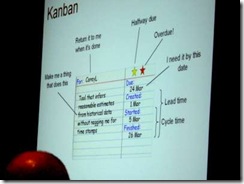San Jose, CA. I’m at (no surprise) SEI’s annual big deal conference, SEPG-NA. As might be expected, attendance is way down due to the economy. SEI had to scale back a lot of the more splashy touches — no-frills tote bag, nixed VIP socials mixers bare bones staff.
 I arrived in time to teach a CMMI-SVC Supplement course for the SEI on Sunday — scheduled to coincide with SEPG for the convenience of travel — that evening I shared conversation and a bottle of really nice California Merlot with Alistair Cockburn, Tami Zemel and Steve Masters. Earlier in the day Alistair listened in on my class from the corridor and over cheese and fruit bluntly reported that the content made his ears bleed. Unfortunately, he’s right. Despite the mostly very positive feedback, there’s only so much charisma can do for certain SEI materials.
I arrived in time to teach a CMMI-SVC Supplement course for the SEI on Sunday — scheduled to coincide with SEPG for the convenience of travel — that evening I shared conversation and a bottle of really nice California Merlot with Alistair Cockburn, Tami Zemel and Steve Masters. Earlier in the day Alistair listened in on my class from the corridor and over cheese and fruit bluntly reported that the content made his ears bleed. Unfortunately, he’s right. Despite the mostly very positive feedback, there’s only so much charisma can do for certain SEI materials.
Alistair challenged me to explain CMMI to him in 5 minutes or less or he’d fall asleep. I believe I succeeded. He Tweeted as much at least. As it turns out, not to either of our surprise, whether using agile terms or traditional terms, if you’re working to improve the experience and situation of "development", you have the same goals and face the same challenges. With that settled we called it a night and met this morning over breakfast to joke about travel anecdotes and strategize our individual plans for the day.
 With other obligations on my plate for this week, this morning I only sat in on half of a half-day tutorial this morning on the excellent topic of The Role of Organizational Culture in Process Improvement. Rather than a bunch of finger-wagging (which, from other presenters, such a topic title might devolve into), anthropologists, Palma Buttles and Fred Valdez, and process improvement uber-guru Judah Mogilensky gave a very well-informed, thoroughly enjoyable, interactive and insightful tutorial on several very specific attributes of culture that affect how to introduce, address and implement process improvement, and the challenges faced by consultants, appraisers and users alike due to culture. Concepts on the perception of time, surface or hidden emotion/expression, stated vs. rewarded values, and so on. During this session, David Anderson arrived. We commiserated over the registration statistics and what it may imply for other large-scale conferences like Agile2009.
With other obligations on my plate for this week, this morning I only sat in on half of a half-day tutorial this morning on the excellent topic of The Role of Organizational Culture in Process Improvement. Rather than a bunch of finger-wagging (which, from other presenters, such a topic title might devolve into), anthropologists, Palma Buttles and Fred Valdez, and process improvement uber-guru Judah Mogilensky gave a very well-informed, thoroughly enjoyable, interactive and insightful tutorial on several very specific attributes of culture that affect how to introduce, address and implement process improvement, and the challenges faced by consultants, appraisers and users alike due to culture. Concepts on the perception of time, surface or hidden emotion/expression, stated vs. rewarded values, and so on. During this session, David Anderson arrived. We commiserated over the registration statistics and what it may imply for other large-scale conferences like Agile2009.
To round-out the day’s sessions I attended Corey Ladas’ mini-tutorial, Launching a Kanban System for Software Engineering. He put up a slide depicting a "waterfall" life cycle which included a "stabilization" phase-gate to which he said, "I don’t think I’m saying anything anyone doesn’t already know will fail." Someone in the audience stopped him to ask (with incredulous tone in her voice), "Are you trying to say that this approach doesn’t work?" <<Snicker.>>
After the tutorial, I headed off to the exhibit area for the "grand opening" of the exhibit hall. As part of the fanfare, a troupe was hired to march around the exhibit hall in oriental dragon costumes accompanied by drums and cymbals. It was festive and lively. Though it would have been more appropriate had they been asked to start things off, lead everyone into the hall, do a circuit around the hall, then be done. Instead, they continued to perform for a lot longer than needed. In addition to causing traffic problems (which wasn’t really a huge issue), they made it hard to speak while nearby. That was an oversight. After a break, they returned to continue, only playing softer. Still, their initial display was too long and they didn’t have to come back. It wasn’t that it was bad, it was merely unnecessary. As for the exhibit hall… so sad… so many fewer, and each booth featured fewer people. The student posters, were a refreshing new feature this year. I was impressed with their efforts, both in terms of research and commitment. First person I ran into was from, of all places, UMBC. Yup, home turf.
Afterwards, David Anderson and his gf joined several of us for a wind-down at the Marriott’s concierge lounge. Well, as I should expect, my increased visibility within SEI and within the CMMI-oriented market has also resulted in never having to sit alone if I didn’t want to. Even then, I didn’t always succeed in getting long stretches of time on my own.



